H3 decays into Z and A1 in the NMSSM
To solve the problem of the Minimal Supersymmetric Standard Model
(MSSM), a single field S is added to build the Next Minimal Supersymmetric Standard
Model (NMSSM). Vacuum enlarged with non-zero vevs of the neutral-even CP is the
combination of Hu, Hd and S. In the NMSSM, the higgs sector is increased to 7 (compared
with 5 higgs in the MSSM), including three higgs – which are the even-CP h1,2,3 (mh1< mh2<
mh3), two higgs – which are odd-CP a1,2 (ma1< ma2) and a couple of charged higgs H .
The decay of higgs into higgs is one of the remarkable new points of the NMSSM. In this
paper we study the decay ofh3 into Zand a1. The decay width is calculated to one loop
vertex correction. The numerical calculation resultson the influence of CP violation are
also given.
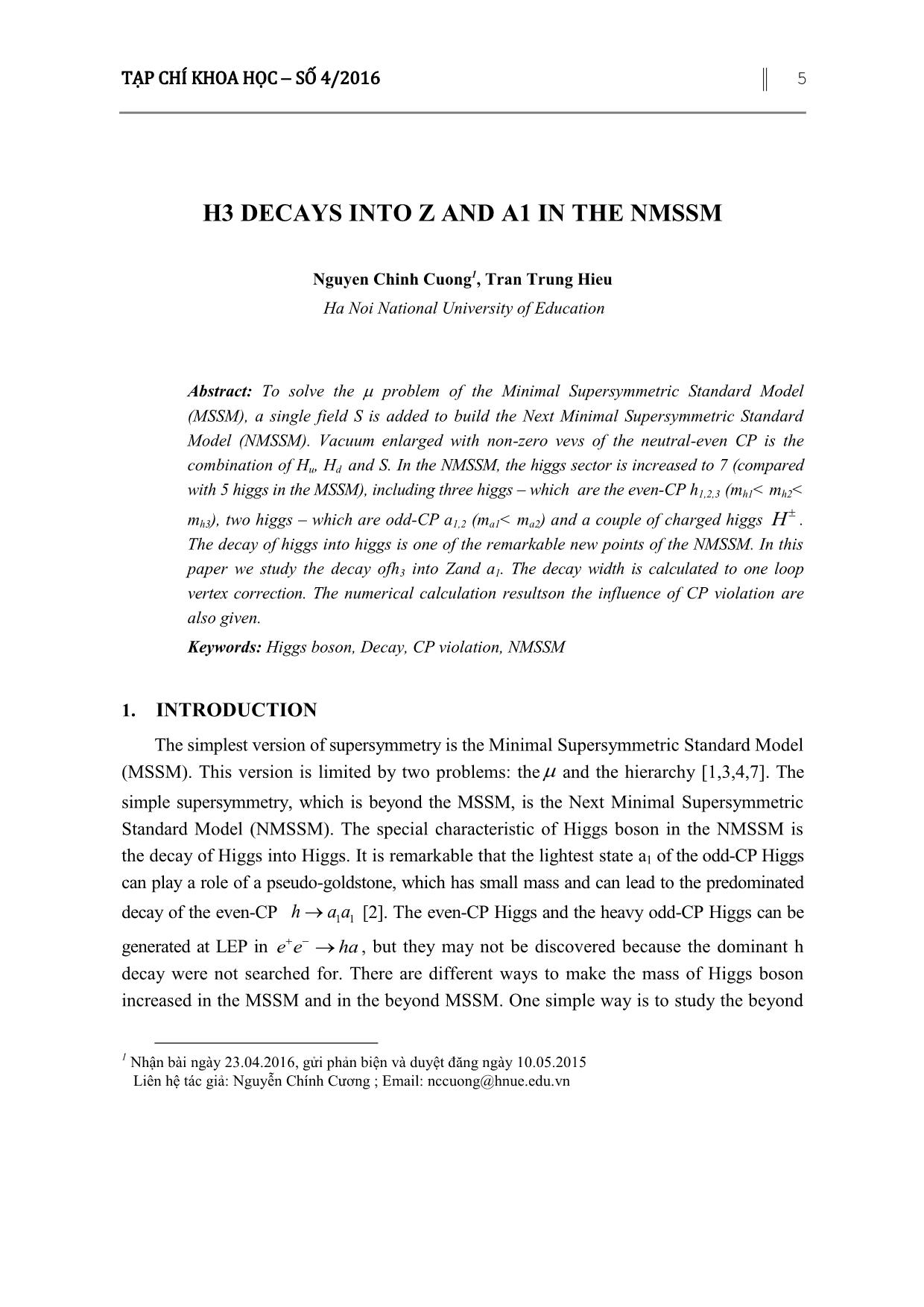
Trang 1
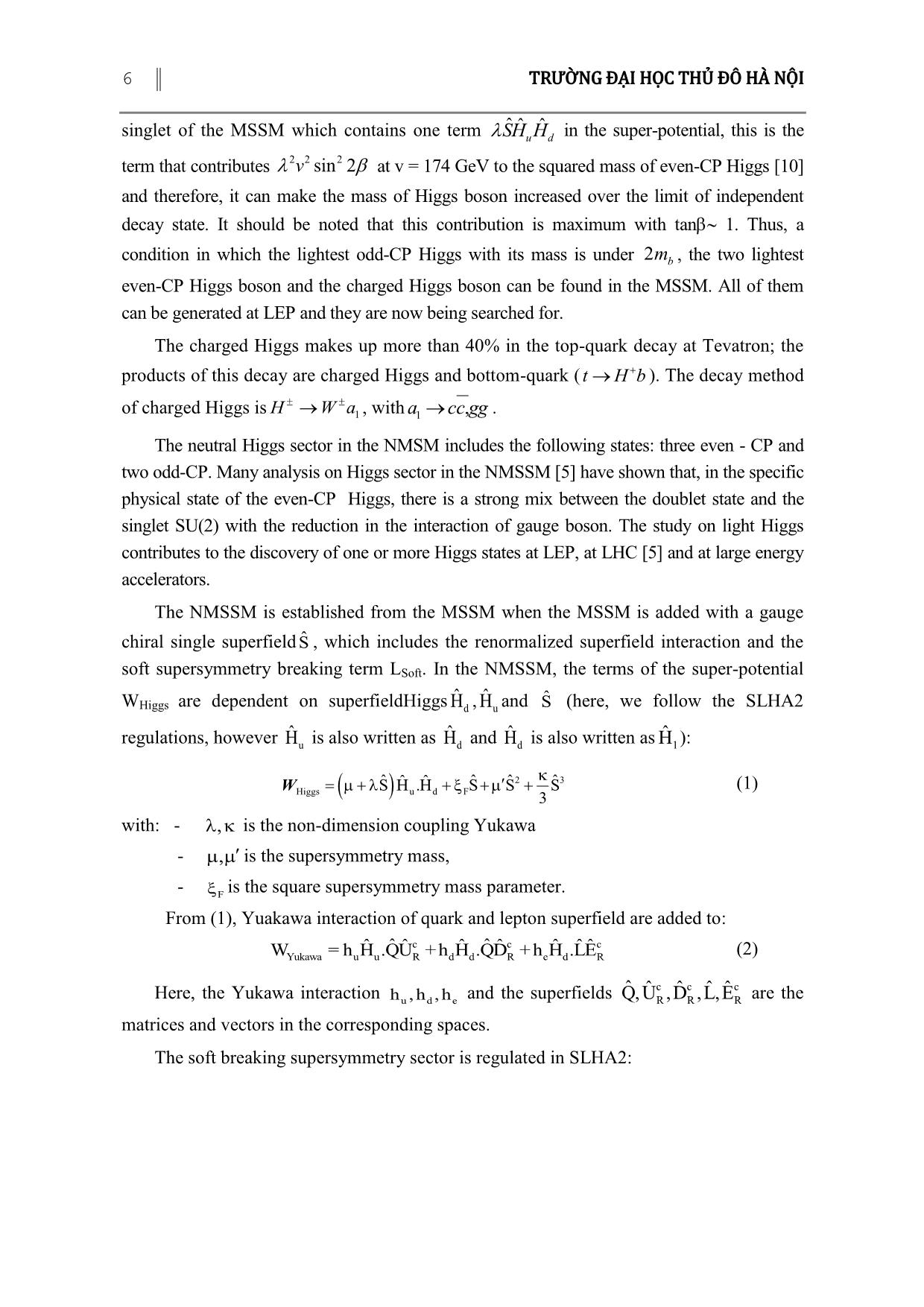
Trang 2
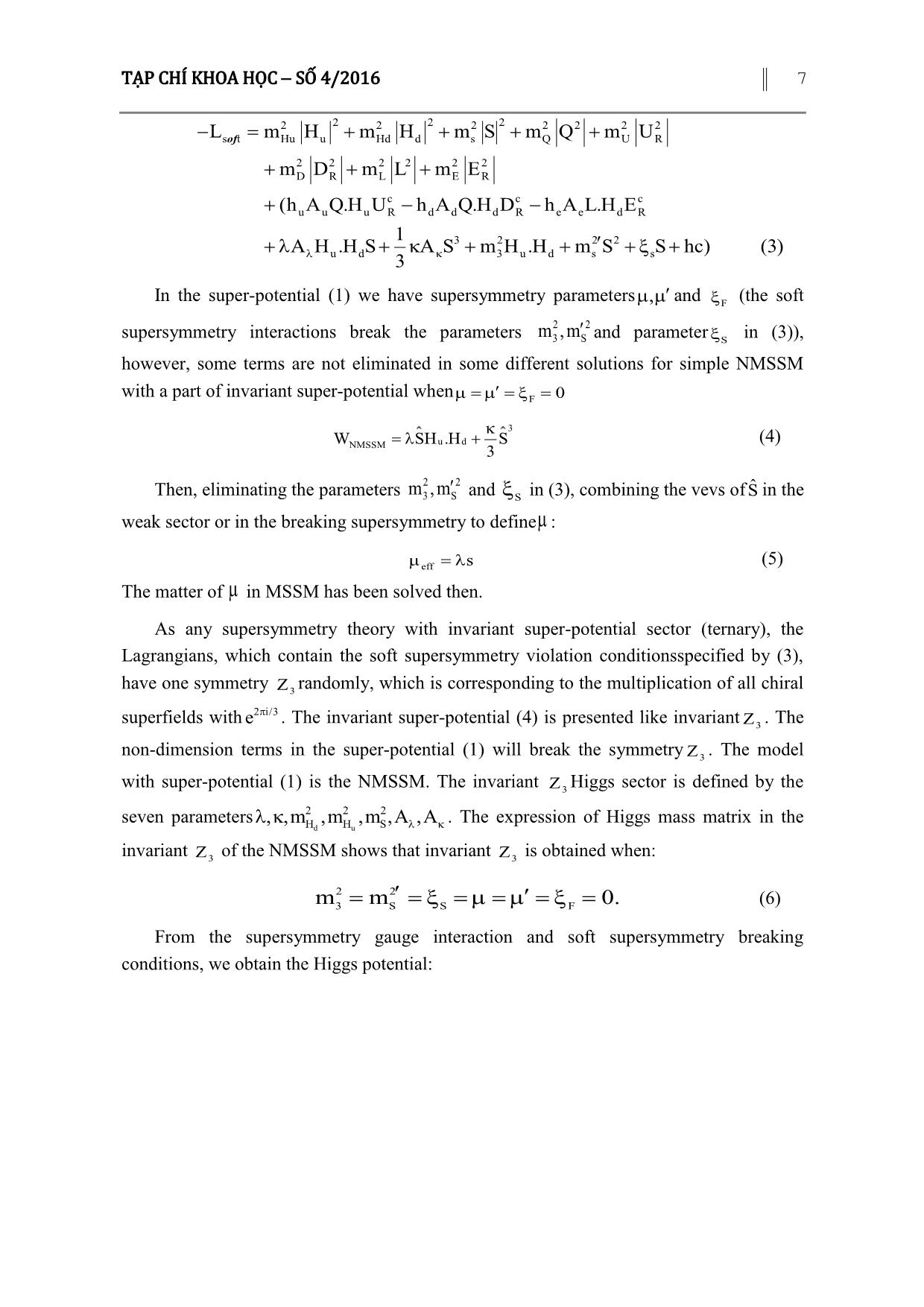
Trang 3
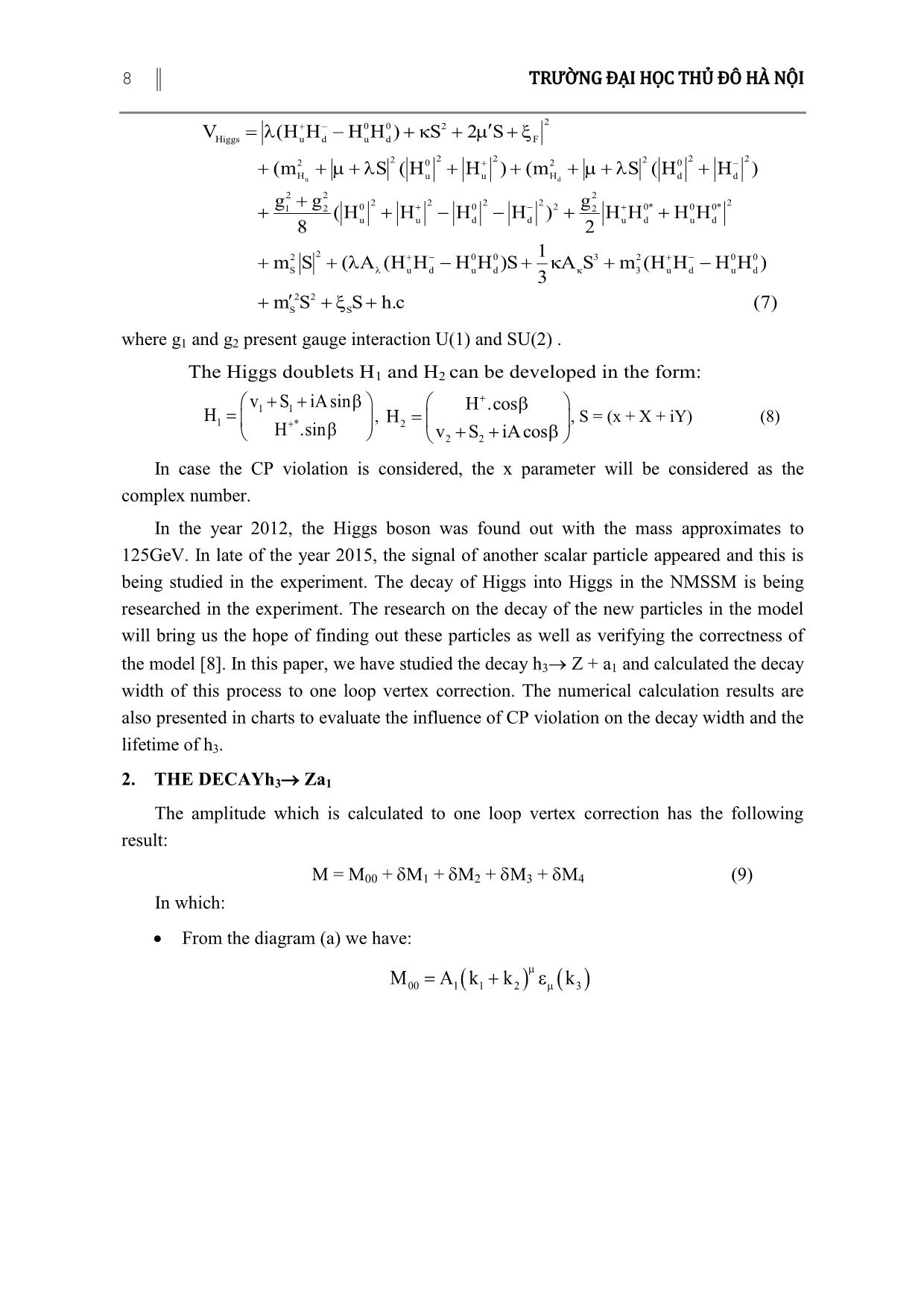
Trang 4
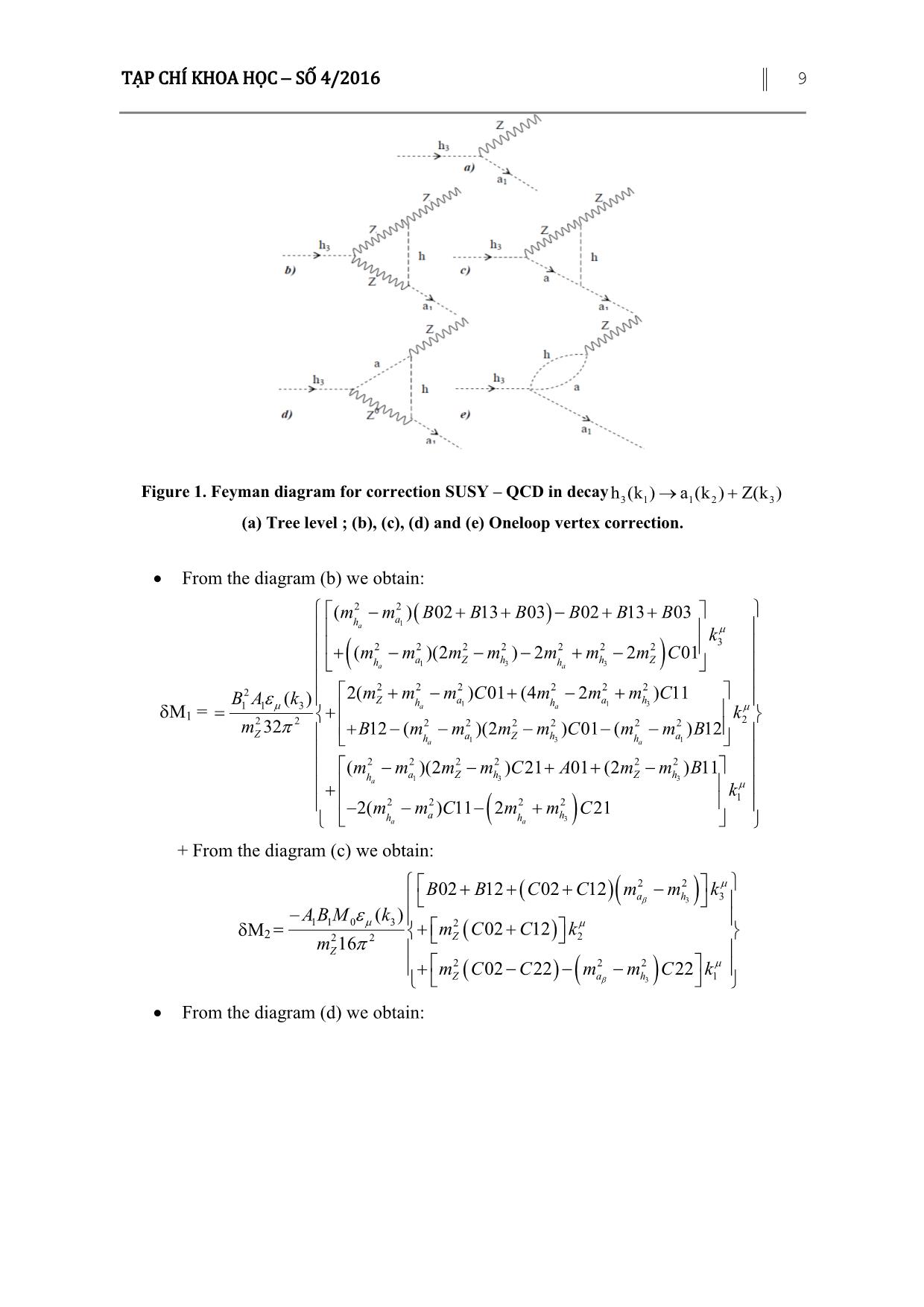
Trang 5

Trang 6
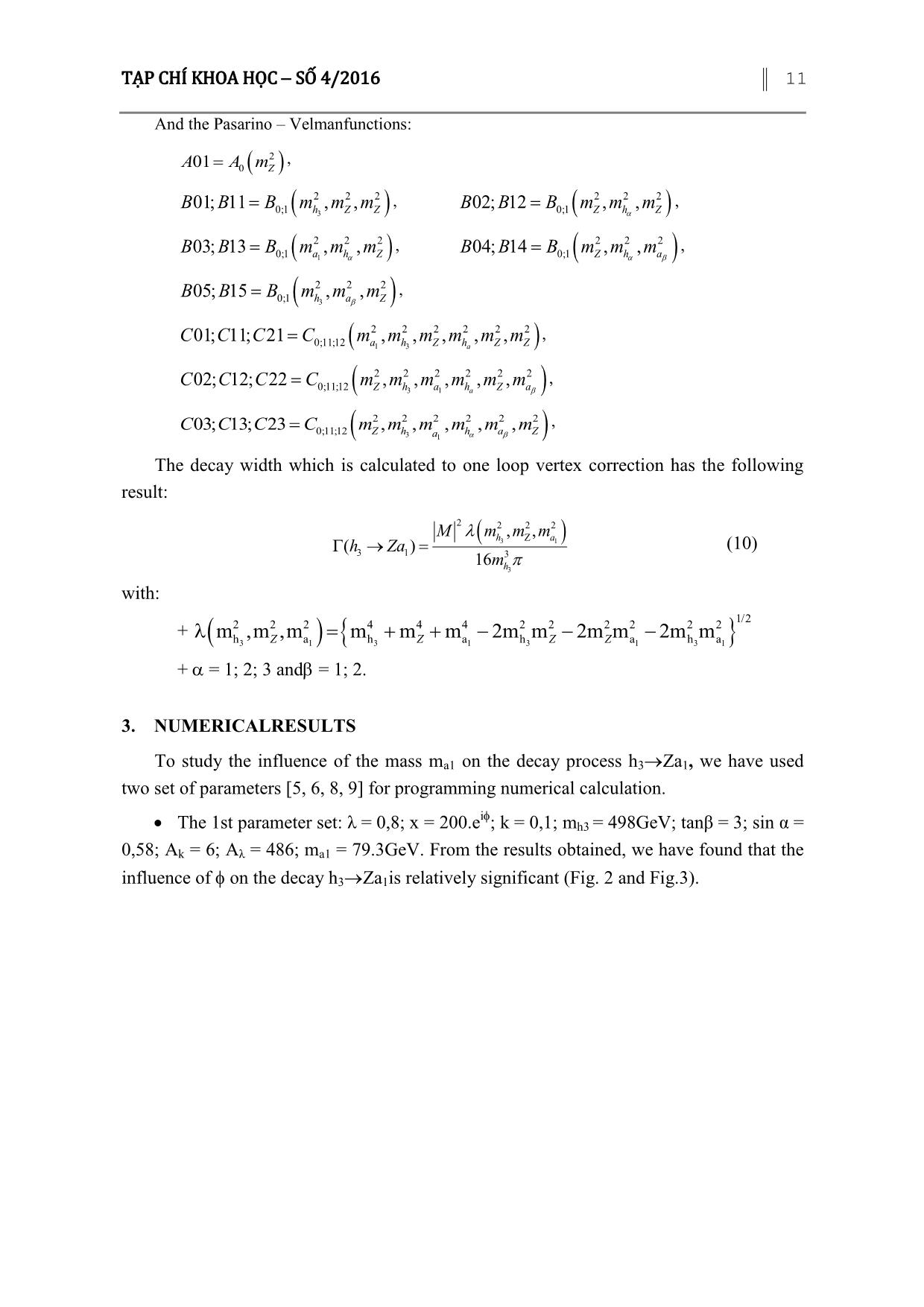
Trang 7
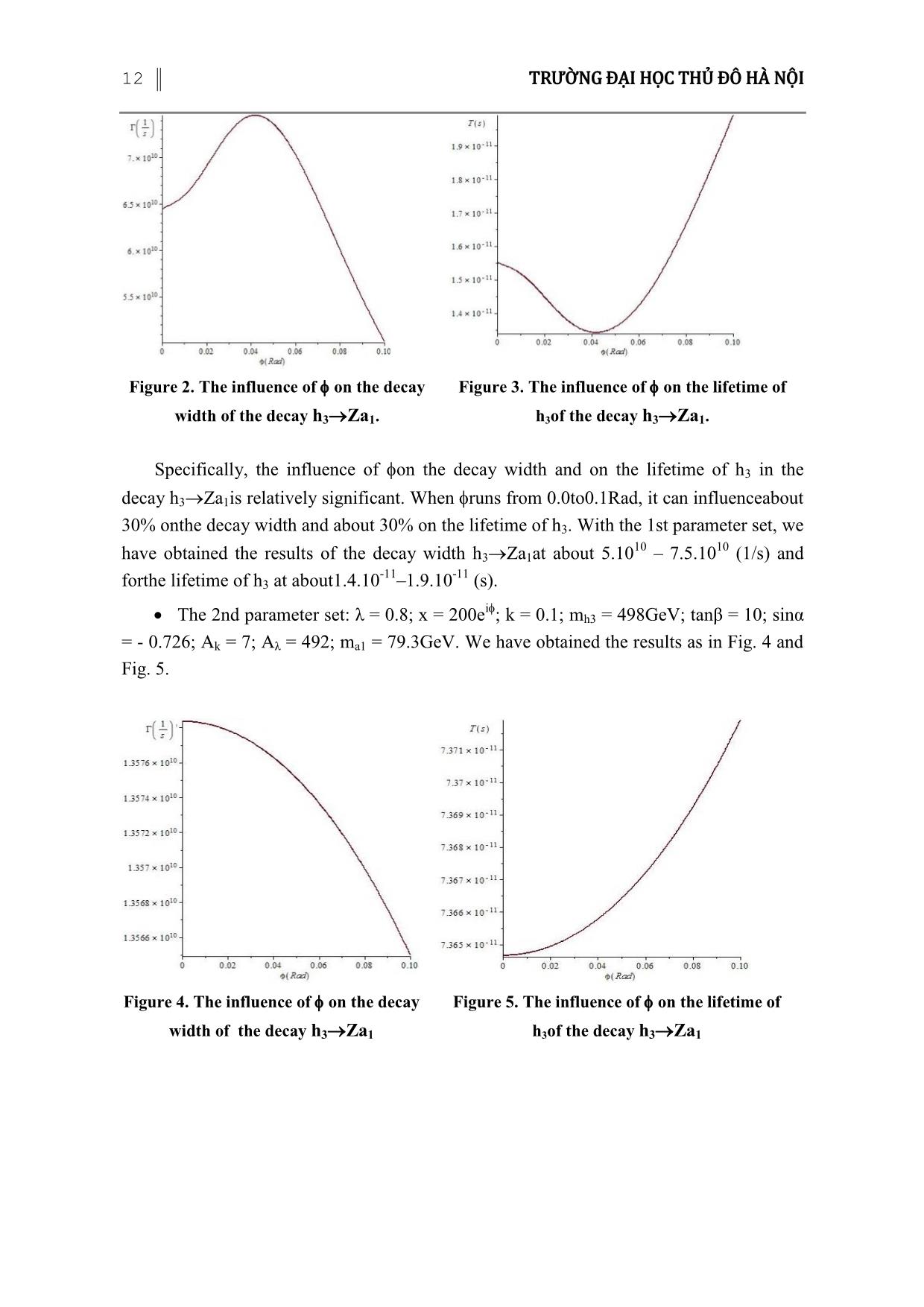
Trang 8
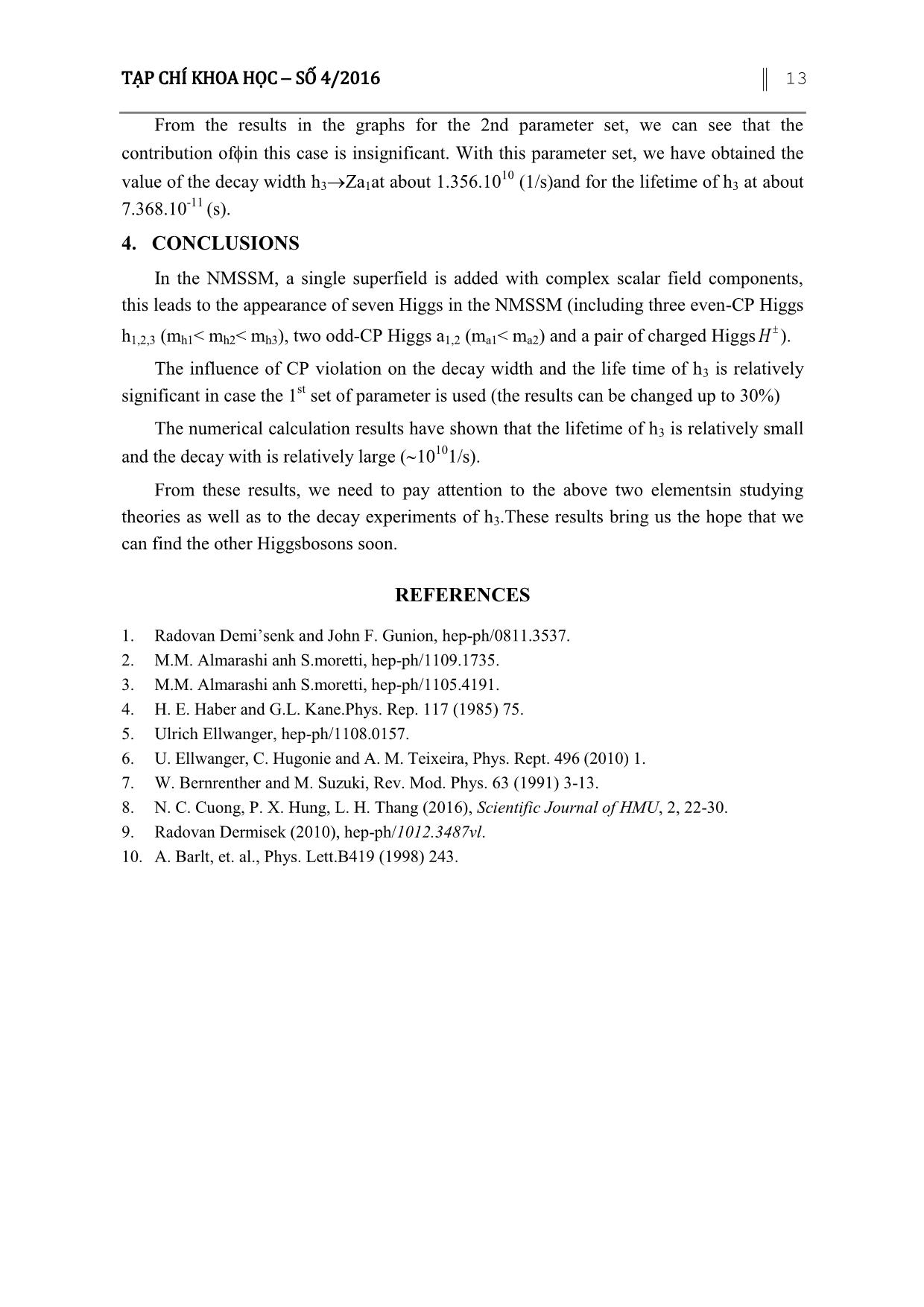
Trang 9
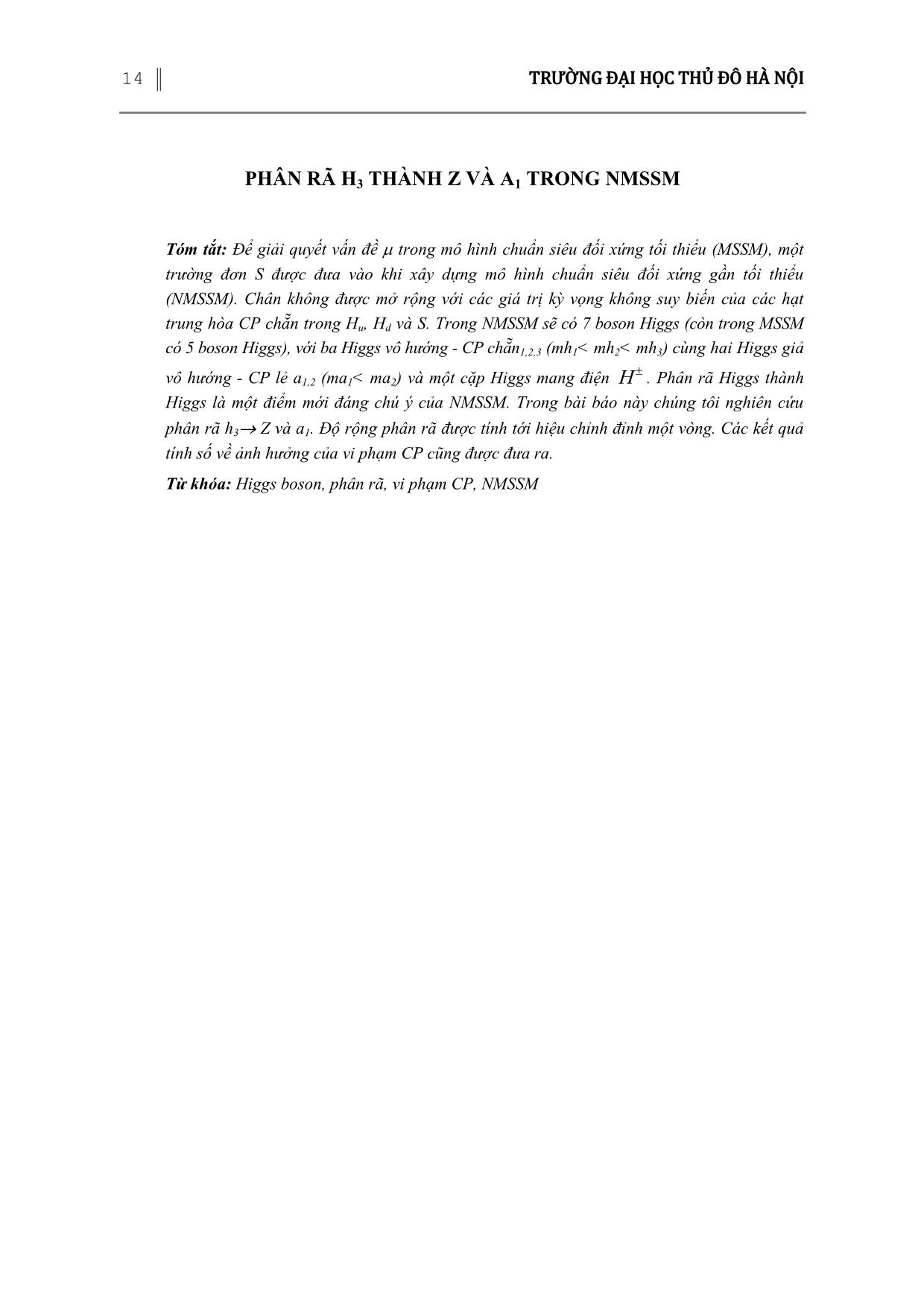
Trang 10
Tóm tắt nội dung tài liệu: H3 decays into Z and A1 in the NMSSM
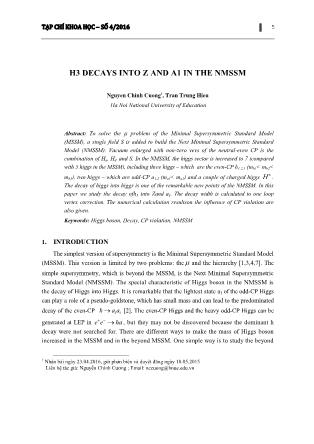
l University of Education Abstract: To solve the problem of the Minimal Supersymmetric Standard Model (MSSM), a single field S is added to build the Next Minimal Supersymmetric Standard Model (NMSSM). Vacuum enlarged with non-zero vevs of the neutral-even CP is the combination of Hu, Hd and S. In the NMSSM, the higgs sector is increased to 7 (compared with 5 higgs in the MSSM), including three higgs – which are the even-CP h1,2,3 (mh1< mh2< mh3), two higgs – which are odd-CP a1,2 (ma1< ma2) and a couple of charged higgs H . The decay of higgs into higgs is one of the remarkable new points of the NMSSM. In this paper we study the decay ofh3 into Zand a1. The decay width is calculated to one loop vertex correction. The numerical calculation resultson the influence of CP violation are also given. Keywords: Higgs boson, Decay, CP violation, NMSSM 1. INTRODUCTION The simplest version of supersymmetry is the Minimal Supersymmetric Standard Model (MSSM). This version is limited by two problems: the and the hierarchy [1,3,4,7]. The simple supersymmetry, which is beyond the MSSM, is the Next Minimal Supersymmetric Standard Model (NMSSM). The special characteristic of Higgs boson in the NMSSM is the decay of Higgs into Higgs. It is remarkable that the lightest state a1 of the odd-CP Higgs can play a role of a pseudo-goldstone, which has small mass and can lead to the predominated decay of the even-CP h a11 a [2]. The even-CP Higgs and the heavy odd-CP Higgs can be generated at LEP in e e ha , but they may not be discovered because the dominant h decay were not searched for. There are different ways to make the mass of Higgs boson increased in the MSSM and in the beyond MSSM. One simple way is to study the beyond 1 Nhận bài ngày 23.04.2016, gửi phản biện và duyệt đăng ngày 10.05.2015 Liên hệ tác giả: Nguyễn Chính Cƣơng ; Email: nccuong@hnue.edu.vn 6 TRƯỜNG ĐẠI HỌC THỦ ĐÔ HÀ NỘI ˆ ˆˆ singlet of the MSSM which contains one term SHud H in the super-potential, this is the term that contributes 2v 22sin 2 at v = 174 GeV to the squared mass of even-CP Higgs [10] and therefore, it can make the mass of Higgs boson increased over the limit of independent decay state. It should be noted that this contribution is maximum with tan 1. Thus, a condition in which the lightest odd-CP Higgs with its mass is under 2mb , the two lightest even-CP Higgs boson and the charged Higgs boson can be found in the MSSM. All of them can be generated at LEP and they are now being searched for. The charged Higgs makes up more than 40% in the top-quark decay at Tevatron; the products of this decay are charged Higgs and bottom-quark (t H b ). The decay method of charged Higgs is H W a1 , with a1 cc, gg . The neutral Higgs sector in the NMSM includes the following states: three even - CP and two odd-CP. Many analysis on Higgs sector in the NMSSM [5] have shown that, in the specific physical state of the even-CP Higgs, there is a strong mix between the doublet state and the singlet SU(2) with the reduction in the interaction of gauge boson. The study on light Higgs contributes to the discovery of one or more Higgs states at LEP, at LHC [5] and at large energy accelerators. The NMSSM is established from the MSSM when the MSSM is added with a gauge chiral single superfield Sˆ , which includes the renormalized superfield interaction and the soft supersymmetry breaking term LSoft. In the NMSSM, the terms of the super-potential ˆ ˆ ˆ WHiggs are dependent on superfieldHiggs Hd , Hu and S (here, we follow the SLHA2 ˆ ˆ ˆ ˆ regulations, however Hu is also written as Hd and Hd is also written as H1 ): ˆˆˆ ˆ ˆ23 ˆ (1) WHiggs S H u .H d F S S S 3 with: - , is the non-dimension coupling Yukawa - , is the supersymmetry mass, - F is the square supersymmetry mass parameter. From (1), Yuakawa interaction of quark and lepton superfield are added to: W = h Hˆ .QUˆˆ ˆc +h H ˆ .QD ˆ c +h H ˆ .LE ˆ ˆ c (2) Yukawa u u R d d R e d R ˆ ˆc ˆ c ˆ ˆ c Here, the Yukawa interaction hu ,h d ,h e and the superfields Q,URRR ,D ,L,E are the matrices and vectors in the corresponding spaces. The soft breaking supersymmetry sector is regulated in SLHA2: TẠP CHÍ KHOA HỌC SỐ 4/2016 7 22 2 2 2 2 2 2 2 2 Lstof mH Huu mH Hdd mSmQmU s Q UR m2 D 2 m 2 L 2 m 2 E 2 DRLER (h A Q.H Uccc h A Q.H D h A L.H E uu uR dd dR ee dR 1 A H .H S A S3 m 2 H .H m 2 S 2 S hc) (3) u d3 u3 d s s In the super-potential (1) we have supersymmetry parameters , and F (the soft 22 supersymmetry interactions break the parameters m3S , m and parameter S in (3)), however, some terms are not eliminated in some different solutions for simple NMSSM with a part of invariant super-potential when F 0 3 WNMSSM SHud .H S (4) 3 22 ˆ Then, eliminating the parameters m3S , m and S in (3), combining the vevs ofS in the weak sector or in the breaking supersymmetry to define : s (5) eff The matter of in MSSM has been solved then. As any supersymmetry theory with invariant super-potential sector (ternary), the Lagrangians, which contain the soft supersymmetry violation conditionsspecified by (3), have one symmetry 3 randomly, which is corresponding to the multiplication of all chiral superfields with e2 i/3 . The invariant super-potential (4) is presented like invariant . The non-dimension terms in the super-potential (1) will break the symmetry 3 . The model with super-potential (1) is the NMSSM. The invariant Higgs sector is defined by the seven parameters , ,m2 ,m 2 ,m,A,A 2 . The expression of Higgs mass matrix in the HHSdu invariant of the NMSSM shows that invariant is obtained when: 22 m3 m0. S SF (6) From the supersymmetry gauge interaction and soft supersymmetry breaking conditions, we obtain the Higgs potential: 8 TRƯỜNG ĐẠI HỌC THỦ ĐÔ HÀ NỘI 0 0 2 2 VHiggs (H u H d H u H d ) S 2 S F 2 2 2 2 (m2 S(H22 0 H)(m 2 S(H 0 H) Hud u u H d d 2 2 2 g g2 2 2 2 g 2 1 2(HHHH)HHHH0 0 2 2 0* 0 0* 82u u d d u d u d 2 1 mS2 (A(HH HH)S 0 0 A S3 m 2 (H H H 0 H 0 ) S u d u d 3 3 u d u d m 22 S S h.c (7) SS where g1 and g2 present gauge interaction U(1) and SU(2) . The Higgs doublets H1 and H2 can be developed in the form: v11 S iAsin H .cos H1 * , H2 , S = (x + X + iY) (8) H .sin v22 S iAcos In case the CP violation is considered, the x parameter will be considered as the complex number. In the year 2012, the Higgs boson was found out with the mass approximates to 125GeV. In late of the year 2015, the signal of another scalar particle appeared and this is being studied in the experiment. The decay of Higgs into Higgs in the NMSSM is being researched in the experiment. The research on the decay of the new particles in the model will bring us the hope of finding out these particles as well as verifying the correctness of the model [8]. In this paper, we have studied the decay h3 Z + a1 and calculated the decay width of this process to one loop vertex correction. The numerical calculation results are also presented in charts to evaluate the influence of CP violation on the decay width and the lifetime of h3. 2. THE DECAYh3 Za1 The amplitude which is calculated to one loop vertex correction has the following result: M = M00 + M1 + M2 + M3 + M4 (9) In which: From the diagram (a) we have: M00 A 1 k 1 k 2 k 3 TẠP CHÍ KHOA HỌC SỐ 4/2016 9 Figure 1. Feyman diagram for correction SUSY – QCD in decayh(k) a(k) Z(k) 3 11 23 (a) Tree level ; (b), (c), (d) and (e) Oneloop vertex correction. From the diagram (b) we obtain: 22 (m ma ) B 02 B 13 B 03 B 02 B 13 B 03 ha 1 k 2 2 2 2 2 2 2 3 (m ma )(2 m Z m h ) 2 m m h 2 m Z C 01 hhaa1 3 3 2 2 2 2 2 2 2 2(m m m ) C 01 (4 m 2 m m ) C 11 B A () k Z a1 a 1 h 3 1 1 3 hhaa M1 = k2 m2232 2 2 2 2 2 2 Z B12 ( m ma )(2 m Z m h ) C 01 ( m m a ) B 12 hhaa1 3 1 2 2 2 2 2 2 (m ma )(2 m Z m h ) C 21 A 01 (2 m Z m h ) B 11 ha 1 3 3 k 2 2 2 2 1 2(m mah ) C 11 2 m m C 21 hhaa 3 + From the diagram (c) we obtain: B02 B 12 C 02 C 12 m22 m k ah 3 3 A1 B 1 M 0 () k 3 m2 C02 C 12 k M2 22 Z 2 mZ 16 m2 C02 C 22 m 2 m 2 C 22 k Z a h3 1 From the diagram (d) we obtain: 10 TRƯỜNG ĐẠI HỌC THỦ ĐÔ HÀ NỘI mmmB2 2 20305 mmmB 2 2 04 2 14 mB 2 B Z h a13 Z a h Z k3 2 2 2 2 2 2 2 2 2 C03 2 Cmmmmm 132 ZZ a h h a mmmm a h a1 31 A3 ()k 1 3 2 2 2 M3 22 2B 13 m m mZ k2 ha 1 mZ 16 2 2 2 2 2B 15 2 C 23 m m m 2mZ 2 2 2 2 a h a1 2C 23 m m m m k a h31 h a 2 2 2 2 ma m h m h m a 31 From the diagram (e) we obtain: iA1E() 1 k 3 k M4 BB04 2 14 16 2 g SPSP igmZ SS and: AU11 U 1 U 2 U 2 aa , BUU112 cossinaa , 2cosW cosW 1 2 ,2 SSPPSSPP E1 i g g UUUUa 1 b 1 1 1 UUUU a 2 b 2 2 2 4 1 2 ,2 22 SSPPSSPPSSPP i g g UUUUa1122 b UUUU a 2211 b 2 ikUUUU a 3333 b 4 2 SSPPSSPPSSPPSS PP i UUUUa1133 b UUUU a 3311 b UUUU a 2233 b UUU a 33 b 22U SSSSPPSSPPPP UUUUUUUUUUUUa12 b a 2133 b a 3312 b 21 SSPPSSPPSSPPSSPP ik UUUUa1323 b UUUU a 3123 b UUUU a 1332 b UUUU a 3132 b UUUUUUUUUUUUUUUSSPPSSPPSSPPSS PPU a2313 b a 3213 b a 2331 b a 323 b 1 2 ,2 gg SPPSPP M0 i vU 1aa 1 U 1 U 1 v 2 U 2 U 2 U 2 22 2 ,2 gg 2 SPPSPP i 2 vU1aa 1 U 2 U 2 v 2 U 2 U 1 U 1 22 22SPPSPP 22ikv 1 vUUU 2 aa 2 3 3 ikv 2 vUUU 1 1 3 3 2 SPPPP 2 SPP 2i xUa3 U 1 U 1 U 2 U 2 i 2 2k x 2 kAka U3 U 3 U 3 2ikU SPPPPPPPP vUU UU vUU UU a3123 32 213 31 A SPPPPSPPPP i 2 kx UUUUUaa1 2 3 3 2 UUUUU 2 1 3 3 1 2 A SPPP P i 2 kx Ua3 U 1 U 2 U 2U 1 2 TẠP CHÍ KHOA HỌC SỐ 4/2016 11 And the Pasarino – Velmanfunctions: 2 , A01 A0 mZ B01; B 11, B , m2 m 2 m 2 , B02; B 12, B , m2 m 2 m 2 , 0;1 h3 Z Z 0;1 Z h Z B03; B 13, B , m2 m 2 m 2 , B04; B 14, B , m2 m 2 m 2 , 0;1 a1 h Z 0;1 Z h a B05; B 15, B , m2 m 2 m 2 , 0;1 h3 a Z C01; C 11; C 21, C , , m2 , m 2 , m 2 m 2 m 2 m 2 , 0;11;12 a13 h Z ha Z Z C02; C 12; C 22 C m2 , m 2 , m 2 , m 2 , m 2 , m 2 , 0;11;12 Z h31 a ha Z a C03; C 13; C 23, C , , m2 , m 2 ,m 2 m 2 m 2 m 2 , 0;11;12 Z h3 a h a Z 1 The decay width which is calculated to one loop vertex correction has the following result: 2 2 2 2 M mha,, mZ m ()h Za 31 (10) 31 16m3 h3 with: 1/2 + m222 ,m ,m m 444 m m 2m 22 m 2m 22 m 2m 22 m h3ZZZZ a 1 h 3 a 1 h 3 a 1 h 3 a 1 + = 1; 2; 3 and = 1; 2. 3. NUMERICALRESULTS To study the influence of the mass ma1 on the decay process h3 Za1, we have used two set of parameters [5, 6, 8, 9] for programming numerical calculation. i The 1st parameter set: λ = 0,8; x = 200.e ; k = 0,1; mh3 = 498GeV; tanβ = 3; sin α = 0,58; Ak = 6; Aλ = 486; ma1 = 79.3GeV. From the results obtained, we have found that the influence of on the decay h3 Za1is relatively significant (Fig. 2 and Fig.3). 12 TRƯỜNG ĐẠI HỌC THỦ ĐÔ HÀ NỘI Figure 2. The influence of on the decay Figure 3. The influence of on the lifetime of width of the decay h3 Za1. h3of the decay h3 Za1. Specifically, the influence of on the decay width and on the lifetime of h3 in the decay h3 Za1is relatively significant. When runs from 0.0to0.1Rad, it can influenceabout 30% onthe decay width and about 30% on the lifetime of h3. With the 1st parameter set, we 10 10 have obtained the results of the decay width h3 Za1at about 5.10 – 7.5.10 (1/s) and -11 -11 forthe lifetime of h3 at about1.4.10 –1.9.10 (s). i The 2nd parameter set: λ = 0.8; x = 200e ; k = 0.1; mh3 = 498GeV; tanβ = 10; sinα = - 0.726; Ak = 7; Aλ = 492; ma1 = 79.3GeV. We have obtained the results as in Fig. 4 and Fig. 5. Figure 4. The influence of on the decay Figure 5. The influence of on the lifetime of width of the decay h3 Za1 h3of the decay h3 Za1 TẠP CHÍ KHOA HỌC SỐ 4/2016 13 From the results in the graphs for the 2nd parameter set, we can see that the contribution ofin this case is insignificant. With this parameter set, we have obtained the 10 value of the decay width h3 Za1at about 1.356.10 (1/s)and for the lifetime of h3 at about 7.368.10-11 (s). 4. CONCLUSIONS In the NMSSM, a single superfield is added with complex scalar field components, this leads to the appearance of seven Higgs in the NMSSM (including three even-CP Higgs h1,2,3 (mh1< mh2< mh3), two odd-CP Higgs a1,2 (ma1< ma2) and a pair of charged Higgs H ). The influence of CP violation on the decay width and the life time of h3 is relatively significant in case the 1st set of parameter is used (the results can be changed up to 30%) The numerical calculation results have shown that the lifetime of h3 is relatively small and the decay with is relatively large (10101/s). From these results, we need to pay attention to the above two elementsin studying theories as well as to the decay experiments of h3.These results bring us the hope that we can find the other Higgsbosons soon. REFERENCES 1. Radovan Demi‟senk and John F. Gunion, hep-ph/0811.3537. 2. M.M. Almarashi anh S.moretti, hep-ph/1109.1735. 3. M.M. Almarashi anh S.moretti, hep-ph/1105.4191. 4. H. E. Haber and G.L. Kane.Phys. Rep. 117 (1985) 75. 5. Ulrich Ellwanger, hep-ph/1108.0157. 6. U. Ellwanger, C. Hugonie and A. M. Teixeira, Phys. Rept. 496 (2010) 1. 7. W. Bernrenther and M. Suzuki, Rev. Mod. Phys. 63 (1991) 3-13. 8. N. C. Cuong, P. X. Hung, L. H. Thang (2016), Scientific Journal of HMU, 2, 22-30. 9. Radovan Dermisek (2010), hep-ph/1012.3487vl. 10. A. Barlt, et. al., Phys. Lett.B419 (1998) 243. 14 TRƯỜNG ĐẠI HỌC THỦ ĐÔ HÀ NỘI PHÂN Rà H3 THÀNH Z VÀ A1 TRONG NMSSM Tóm tắt: Để giải quyết vấn đề trong mô hình chuẩn siêu đối xứng tối thiểu (MSSM), một trường đơn S được đưa vào khi xây dựng mô hình chuẩn siêu đối xứng gần tối thiểu (NMSSM). Chân không được mở rộng với các giá trị kỳ vọng không suy biến của các hạt trung hòa CP chẵn trong Hu, Hd và S. Trong NMSSM sẽ có 7 boson Higgs (còn trong MSSM có 5 boson Higgs), với ba Higgs vô hướng - CP chẵn1,2,3 (mh1< mh2< mh3) cùng hai Higgs giả vô hướng - CP lẻ a1,2 (ma1< ma2) và một cặp Higgs mang điện H . Phân rã Higgs thành Higgs là một điểm mới đáng chú ý của NMSSM. Trong bài báo này chúng tôi nghiên cứu phân rã h3 Z và a1. Độ rộng phân rã được tính tới hiệu chỉnh đỉnh một vòng. Các kết quả tính số về ảnh hưởng của vi phạm CP cũng được đưa ra. Từ khóa: Higgs boson, phân rã, vi phạm CP, NMSSM
File đính kèm:
 h3_decays_into_z_and_a1_in_the_nmssm.pdf
h3_decays_into_z_and_a1_in_the_nmssm.pdf

